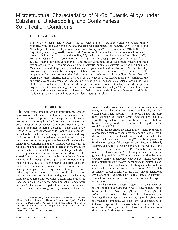摘要
Both Ni-36 wt pct Sb and Ni-52.8 wt pct Sb eutectic alloys were highly undercooled and rapidly solidified with the glass-fluxing method and drop-tube technique. Bulk samples of Ni-36 pct Sb and Ni-52.8 pct Sb eutectic alloys were undercooled. by up to 225 K (0.16 T-E) and 218 K (0.16 TE), respectively, with the glass-fluxing method. A transition from lamellar eutectic to anomalous eutectic was revealed beyond a critical undercooling DeltaT(1)*, which was complete at an undercooling of DeltaT(2)*. For Ni-36 pct Sb, DeltaT(1)* approximate to 60 K and DeltaT(2)* approximate to 218 K; for Ni-52.8 pct Sb, DeltaT(1)* approximate to 40 K and DeltaT(2)* approximate to 139 K. Under a drop-tube containerless solidification condition, the eutectic microstructures of these two eutectic alloys also exhibit such a "lamellar eutectic-anomalous eutectic" morphology transition. Meanwhile, a kind, of spherical anomalous eutectic grain was found in a Ni-36 pct Sb eutectic alloy processed by the drop-tube technique, which was ascribed to the good spatial symmetry of the temperature field and concentration field caused by a reduced gravity condition during free fall. During the rapid solidification of a Ni-52.8 pct Sb eutectic alloy, surface nucleation dominates the nucleation event, even when the undercooling is relatively large. Theoretical calculations on the basis of the current eutectic growth and dendritic growth models reveal that gamma-Ni5Sb2 dendritic growth displaces eutectic growth at large undercoolings in these two eutectic alloys. The tendency of independent nucleation of the two eutectic phases and their cooperative dendrite growth are responsible for the lamellar eutectic-anomalous eutectic microstructural transition.
- 出版日期2002-4
- 单位西北工业大学
